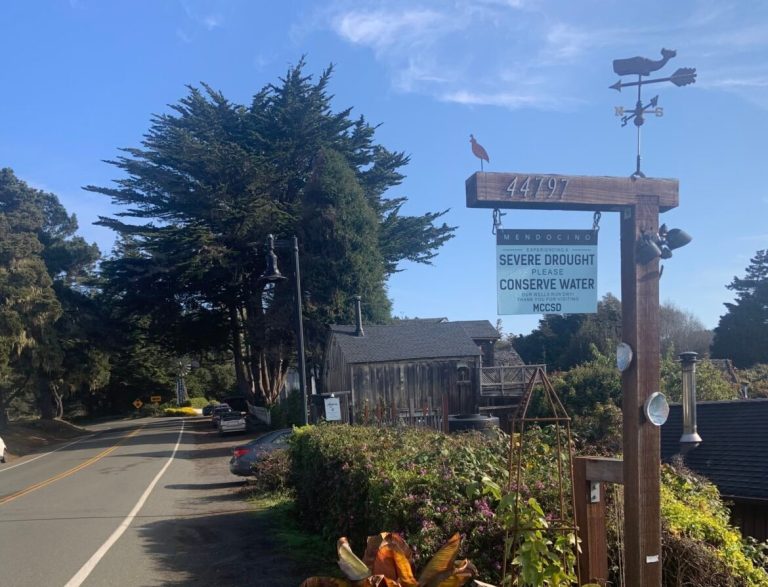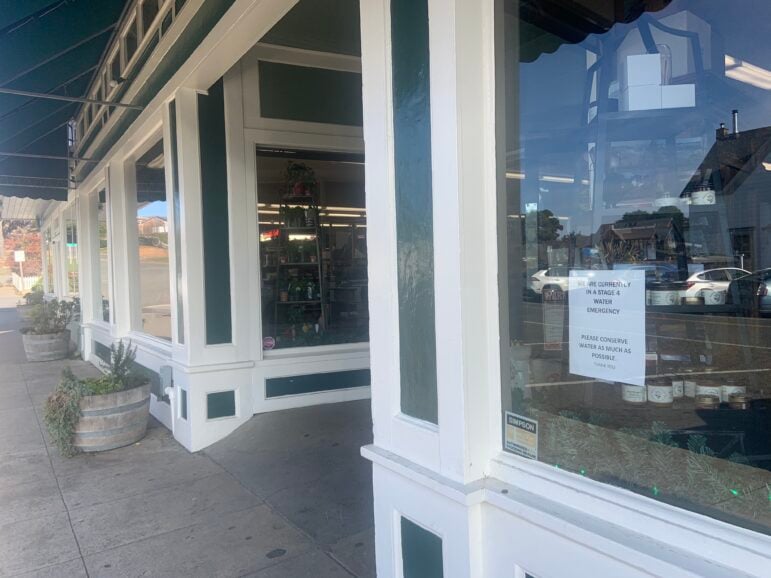
MENDOCINO, CA, 12/14/22 — Does drought affect Teddy Winslow’s business, the breakfast and lunch spot GoodLife Cafe & Bakery open seven-days-a-week on Mendocino’s well-trodden Lansing Street?
“We’re currently monitoring our well, which basically provides water for the entire block that my restaurant resides on,” Winslow, who’s owned the cafe since 2012, told The Mendocino Voice in a phone conversation this winter. “The well runs dry about once a week, and we have to purchase water from [a delivery driver] who lives in Comptche — but he has to drive all the way to Fort Bragg and then drop it off at my place, which I believe costs my landlord around $500 or $600 a time. … At a certain point he’s going to stop paying the amount and charge the commercial tenants for that water — I think it’s a $10,000 cut-off that he put into the lease. So, I’m very conscious of how much water we’re using constantly.”
An attentive business owner, Winslow wants to do right by both her environment and her community. She’s installed water-saving features in the kitchen, like a low-flow, high-impact sprayer for washing dishes and a “double-sided” dishwasher to clean two loads with the same amount of water a regular appliance would use. But GoodLife’s other necessary water conservation measures, such as replacing plates with metal trays with paper liners (which are easier to clean), infringe on the environmental ethics that are also part of Winslow’s business philosophy.
Advertisements
“I’m trying to basically buy everything as eco-friendly as possible,” she explained. “We’ve got wood cutlery and compostable and recyclable cups, and everything is in the effort to try and make less of an impact on the planet. Then meanwhile with the drought, we’re needing to buy things that are not necessarily good for the planet. So it’s a really hard place for us to be in, [to] have to up our consumption on paper and plastic.”
 Teddy Winslow smiles with her son Simon, who’s the same age as her bakery. (Courtesy of Teddy Winslow)
Teddy Winslow smiles with her son Simon, who’s the same age as her bakery. (Courtesy of Teddy Winslow)
When Winslow saw that Mendocino had been named in the “American West” section of Fodor’s “No List” 2023, discouraging tourists from visiting destinations struggling with water access, she felt mixed emotions. The town itself has some 800 permanent residents, and an estimated 50-60% of Winslow’s business comes from out-of-town visitors — but she appreciated the article for “trying to raise our attention to the issues.”
Advertisements

What’s the No List?
The list suggests “regions to reconsider” in travel for the coming year, spanning destinations around the globe. This year, the travel publication focused on three categories: “natural attractions that could use a break in order to heal and rejuvenate; cultural hotspots that are plagued with overcrowding and resource depletion; and locations around the world immediately and dramatically impacted by water crises.” Nine reporters contributed.
“This year’s No List does not serve as a boycott, ban, or cancellation of any sort; but a call to travelers to consider wisely the choices we make,” they wrote. “We can have a positive impact on this world we love so dearly.”
But a hungry news cycle makes ending up on something called the “No List” understandably undesirable. Other publications including SF Gate, Mercury News, and even Trip Advisor have picked up the story, citing “two California destinations” (the other being Lake Tahoe, which was listed individually due to concerns about tourism’s impact on the landscape) named to the list. For a county of around 90,000 permanent residents, which relies heavily on the travel industry to generate some $46.1 million in revenue and more than 5,000 jobs, that’s not ideal.
“It’s not really an accurate interpretation,” Ryan Rhoades, superintendent of the Mendocino City Community Services District (MCCSD), said of some of the follow-up pieces. “Because if you read the Fodor’s article, what they’re trying to do is make people into more conscious travelers and help people make informed decisions.”
Rhoades, who manages groundwater in the village for MCCSD, said both aspects of the issue are personal for him; his wife waitresses at a restaurant in town, and he has another job running an event planning business.
Advertisements

“When the restaurant said, ‘Well, we may have to close [for a day] because we don’t have enough water or trucked water is getting expensive,’ she might lose a shift of work, and that has a direct impact on us,” he said, adding, “I think it’s really good that they’re trying to increase awareness of human impact on the environment and how climate change is affecting different regions of the world, to make us more conscious citizens and travelers.”
The village of Mendocino struggles with water storage as some rainfall, rather than soaking into the earth to become groundwater, runs into springs off the headlands’ cliffs. In the article’s comments section, some expressed frustration that other small towns in California have experienced similar challenges with shallow groundwater and inadequate storage infrastructure, but were not singled out by name.
“All industries place demand on infrastructure, whether roads, water, emergency response, trails, trash, street sweeping or other,” wrote Ted Williams, chair of Mendocino County Board of Supervisors and representative for the fifth district, in an email to The Voice. “In 2022, California has the ingenuity to ensure adequate water supply.”
Advertisements

Williams, and representatives for tourism group Visit Mendocino County (VMC), said they were not contacted by the outlet prior to publication. Fodor’s editors did not return The Voice’s requests for comment on their methodology in crafting the list.
Due to the county’s economic reliance on tourism, Williams took issue with the implication that less tourist traffic would improve water access — rather than hinder the county’s ability to improve the coast’s water infrastructure. He wrote, “Visitors in search of endless hot showers would be better served elsewhere, but most of the people who visit our county are with us to enjoy the vast unspoiled landscapes, small town culture and peace.”
Advertisements

Under Stage 4 water shortage emergencies, which have occurred three times in the past two years, the town of Mendocino reduced water allotments, restricted hosing of buildings and sidewalks, and mandated that restaurants only provide water by request. In September, the MCCSD downgraded the water crisis to Stage 2, which reduces restrictions to a requested 15% water usage reduction. MCCSD provides a plethora of water conservation resources on its website. Further, posters up and down the coast encourage water conservation; such education campaigns can help reiterate the importance of responsibility to visitors from out of town.
“Currently the website doesn’t have many ‘travel cautions’ or ‘how tos’ that address this issue,” Executive Director Travis Scott wrote of Visit Mendocino County’s messaging. “However, in late January [Visit Mendocino County] is launching a new website and with its expanded capabilities there will be a section to address stewardship and environmental issues in terms of traveling consciously in Mendocino County — these stewardship pillars will pair with Visit California’s Stewardship Objectives for continuity in messaging.”
Scott also said that many visitors coming from elsewhere in California are familiar with drought, and that lodging partners have reported “a net savings in water” due to this demographic consideration. But individuals and business owners like Winslow — especially those who work in hospitality — shoulder a burden to solve their own water struggles on a case-by-case basis while supporting Mendocino County’s economic welfare.
“It’s up to the small businesses to try and keep our heads above water, while we try and take care of our problems with the garbage and the drought and the water and everything else,” she said. “It’s kind of insane to me actually, for how much money comes through … how little comes back our way to solve our problems and help us survive.”
‘Get Started Yesterday’: Addressing Drought
Though the village of Mendocino is a coveted Northern California destination off Highway 1, it’s also an unincorporated community — which means tax dollars from the village aren’t funneled directly back into its own infrastructure, but rather into county coffers under the supervisors’ jurisdiction. The local MCCSD sees about $100,000 of county property taxes, all of which go toward managing the wastewater treatment plant — the majority of its operating budget is made up through fees charged for sewer use, water meter readings, and more.
Advertisements

Williams says the county is focused on addressing water considerations — but there are limits to what can be accomplished.
“Water infrastructure is expensive, often in the tens to hundreds of millions of dollars,” Williams wrote. “The county is engaged in advocating for state funds. Nothing stops residents and businesses from self-funding water upgrades. Businesses are in a position of deciding whether to go it alone (either through greater winter storage or delivery at peak dryness) or support assessments to collectively build shared water systems.”
The supervisors hope that revamping Mendocino County’s Water Agency will help increase access to those state funds and other key infrastructure supports. In a recent agenda item, staff hoped to hire EKI Environment & Water, Inc. to serve as the water resource specialist to identify options in addressing water challenges.
In the village, MCCSD was recently awarded a $4.2 million grant from the State Department of Water Resources to plan, design, and construct a 500,000 gallon water tank on Mendocino Unified School District property to enhance water storage capabilities. As Rhoades wrote in a letter notifying the community of the grant award, this project was a priority because “one big structure fire could wipe out” the district’s existing emergency water supply, which feeds fire hydrants in town.
Rhoades’ district also promotes water resiliency through conservation measures and education campaigns. He said the village recently applied to conduct a feasibility study through the state water board’s environmental justice-focused SAFER program, to explore different methods of enhancing water infrastructure in Mendocino.
Advertisements

“We’re committed to improving our water security and having the conversation with the community about what that might look like,” Rhoades explained. “Could that be a community water system? Could that be additional storage tanks? Could that be connecting with neighboring systems? What we need to do is explore all the different possibilities.”
Advertisements

 Harvest Market at Mendosa’s, a Lansing Street grocery store frequented by visitors and locals alike, has several signs reminding of the village’s water crisis. (Kate Fishman/The Mendocino Voice)
Harvest Market at Mendosa’s, a Lansing Street grocery store frequented by visitors and locals alike, has several signs reminding of the village’s water crisis. (Kate Fishman/The Mendocino Voice)
‘We All Do Better When We Help One Another’
As it stands, Mendocino often relies on Fort Bragg to sell water and keep the smaller village’s water access afloat.
“That’s one of the special things about the coast is that we’re neighbors helping neighbors, and we all do better when we help one another,” Rhoades said. “Fort Bragg’s been great about that.”
But last year, when the Noyo River experienced historically low flows, Fort Bragg was forced to cut Mendocino off to conserve water for its own population and businesses.
“Hopefully we’ll be able to continue to provide them water,” Mayor Bernie Norvell said in a conversation with The Voice. “But if it gets to a point where we can’t, we have to make that hard decision again to shut off outside sales — and that is a very hard decision because they may not live in the city and pay for the infrastructure with the water rates, but they are members of our community. It’s tough to shut them off, because they really don’t have anywhere else to go. The answer that the county came up with solved the problem last year, but it’s not sustainable. We can’t continue to keep trucking treated water from Ukiah to Fort Bragg and then [retreating it] through our system and then trucking it out. It’s just way too expensive.”
Advertisements

John Smith, Fort Bragg’s public works director, brought a plan before the city council this month to install three reservoirs in Fort Bragg to hold a possible total of 44 million gallons of water. Fort Bragg is also pursuing cutting-edge technology such as wave energy-powered desalination to foster a more reliable, sustainable supply of water. The projects are ambitious and costly — but in Norvell’s words, new infrastructure is absolutely necessary, “so just get started yesterday.”
Fort Bragg, which has pursued “blue economy” efforts to utilize the incredible resource of the ocean at the intersection of science, tourism, and sustainability, is also a prime vacation destination. After all, the city’s Main Street is Highway 1. Given the strides the city is making toward more sustainable water practices, Norvell found the Mendocino mention in the list short-sighted.
“I don’t know that I would go as far as to say that article was irresponsible because I’m sure it was well intended,” he said. “But I’d hate to see it have an adverse effect.”
He pointed out that, while tourism generates revenue for the county, the county also funnels a lot of resources into providing a good experience for travelers — around $433.1 million per year.
“There is a lot of big money being spent on bringing people here,” Norvell said. “And we need a return on that.”
Advertisements

For Winslow, who grew up in Mendocino and is raising a son who’s the same age as her bakery, addressing water issues in the village — and countywide — is critical to ensure that the people who love it so much can stay here, and keep it a hospitable and magical place for visitors.
“Obviously, we all want the tourism and the income — that’s not a question,” Winslow said. She added, “But I do want those tourists to maybe not take long baths every single day because it’s not their water or, you know, just have a mindless attitude. I want them to read that article, and I want them to understand what we’re dealing with, so they can have a little bit of respect and consciousness when they visit.”
Note: Kate Fishman covers the environment & natural resources for The Mendocino Voice in partnership with a Report For America. Her position is funded by the Community Foundation of Mendocino, Report for America, & our readers. You can support Fishman’s work with a tax-deductible donation here or by emailing [email protected]. Contact her at KFishman@mendovoice.com or at (707) 234-7735. The Voice maintains editorial control and independence.